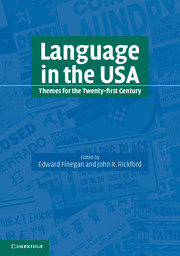Book contents
- Frontmatter
- Contents
- List of figures
- List of tables
- List of contributors
- Acknowledgments
- Foreword
- Editors' preface
- Part 1 American English
- 1 American English: its origins and history
- 2 American English and its distinctiveness
- 3 Regional dialects
- 4 Social varieties of American English
- 5 African American English
- 6 The Dictionary of American Regional English
- Part 2 Other language varieties
- Part 3 The sociolinguistic situation
- Index
6 - The Dictionary of American Regional English
Published online by Cambridge University Press: 05 June 2012
- Frontmatter
- Contents
- List of figures
- List of tables
- List of contributors
- Acknowledgments
- Foreword
- Editors' preface
- Part 1 American English
- 1 American English: its origins and history
- 2 American English and its distinctiveness
- 3 Regional dialects
- 4 Social varieties of American English
- 5 African American English
- 6 The Dictionary of American Regional English
- Part 2 Other language varieties
- Part 3 The sociolinguistic situation
- Index
Summary
Editors' introduction
This chapter provides an introduction to the Dictionary of American Regional English (DARE) by its Chief Editor, who has been associated with the project since 1975. Associate Editor for many years, Joan Houston Hall became Chief Editor of DARE in 2000, when Frederic G. Cassidy, the founding Director and Chief Editor, died. DARE is one of the most comprehensive and accessible public resources on variation in American dialects, drawing on fieldwork conducted between 1965 and 1970 in more than 1,000 communities across the USA, and supplemented by the evidence of thousands of literary and other sources. Four of a projected six volumes have appeared to date, with completed entries running through Sk-.
The chapter describes several aspects of the fieldwork for DARE, including its extensive questionnaire (with 1,687 to 1,847 questions), and the way in which responses were electronically tabulated and analyzed, with the results indicated on DARE maps whose dimensions were poportional to the population density in each state. This chapter complements chapter 3 on regional dialects in that it shows how the 1940s distribution of variant words (like darning needle and other words for ‘dragonfly’ discussed in chapter 3) had spread west and otherwise changed (or not) in the intervening years. One of the conclusions of this chapter is similar to that of William Labov (cited in chapter 3): despite greater mobility and the influence of mass media, American English has not become homogenized, but shows striking regional variation.
- Type
- Chapter
- Information
- Language in the USAThemes for the Twenty-first Century, pp. 92 - 112Publisher: Cambridge University PressPrint publication year: 2004
- 2
- Cited by

